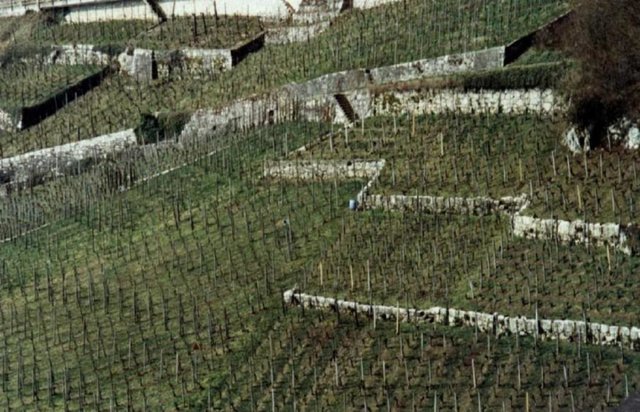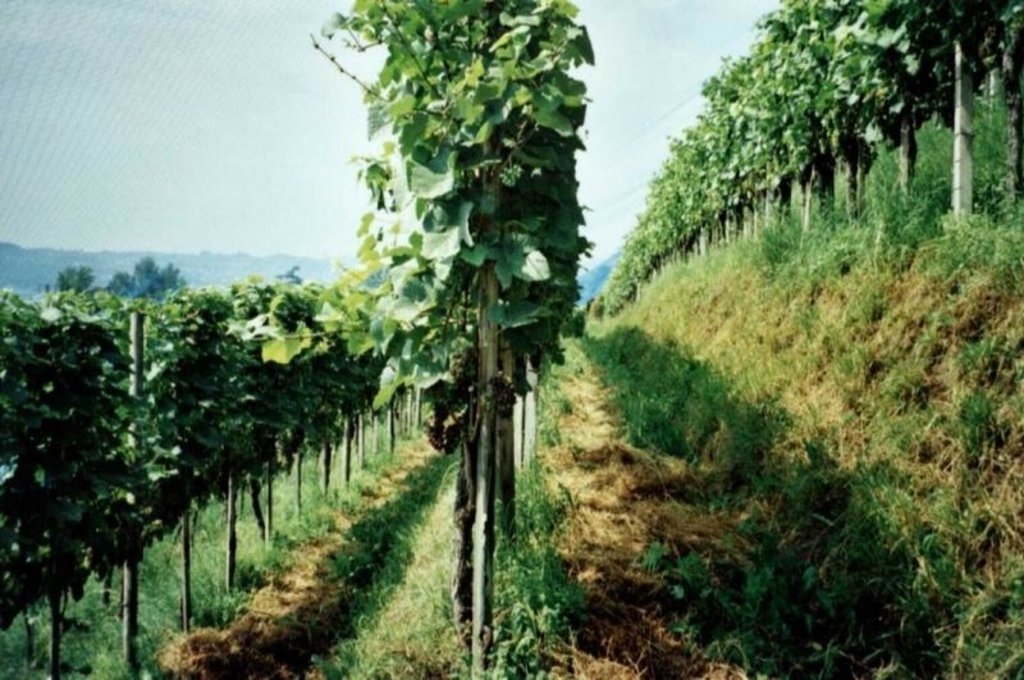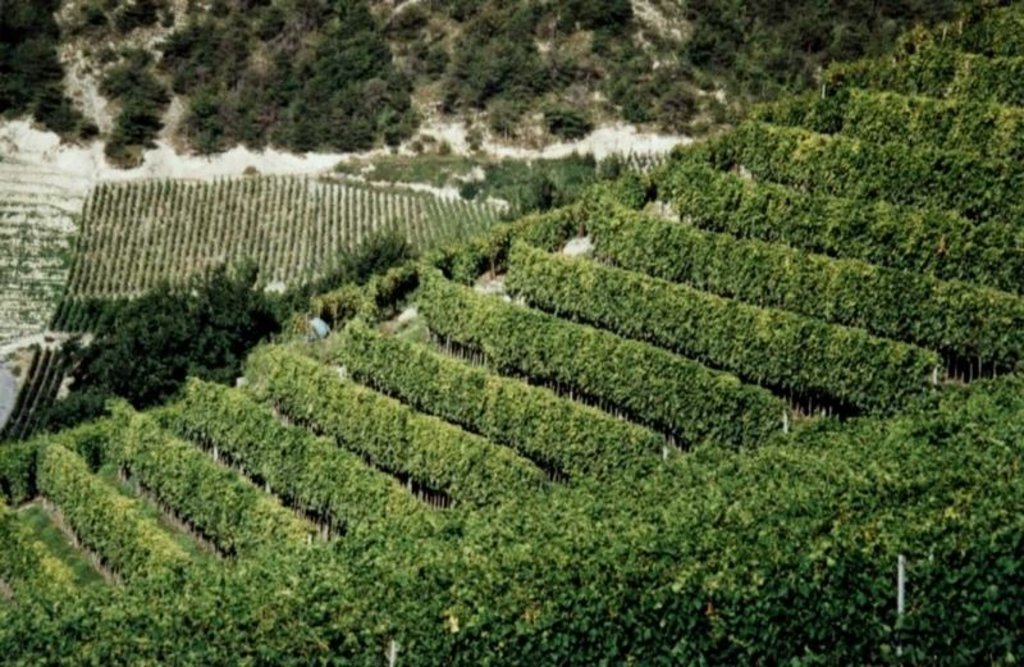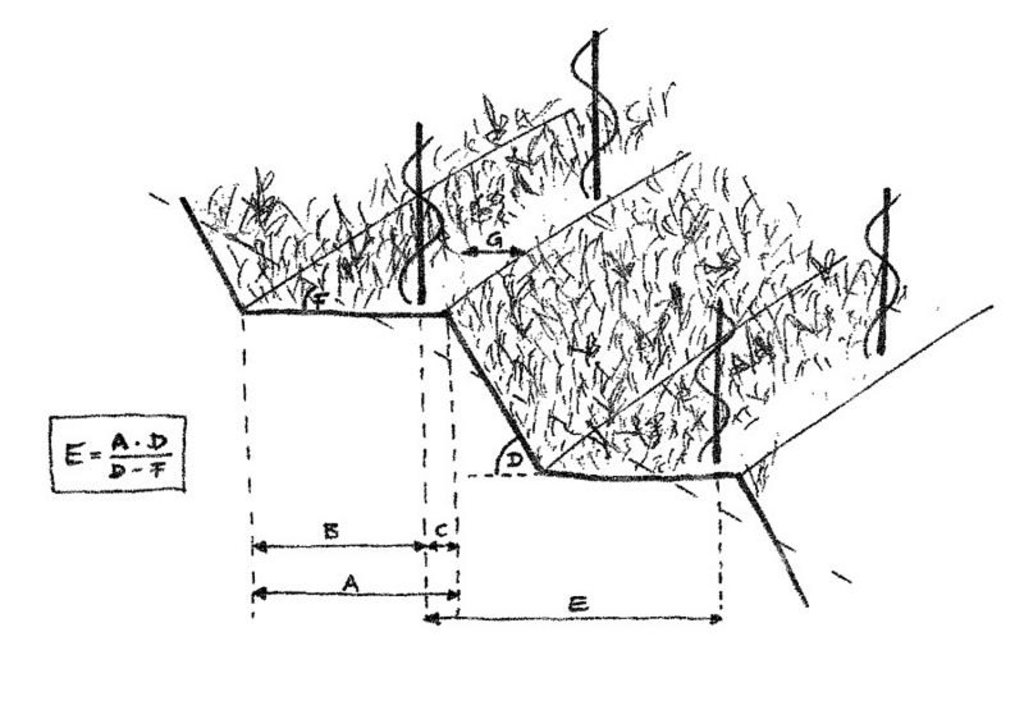Contour small bench terraces with permanent green cover in vineyards [Suiza]
- Creación:
- Actualización:
- Compilador: Nicole Guedel
- Editor: –
- Revisor: Fabian Ottiger
Ganzjährig begrünte Kleinterrassen im Rebbau
technologies_1011 - Suiza
Visualizar secciones
Expandir todo Colapsar todos1. Información general
1.2 Detalles de contacto de las personas de referencia e instituciones involucradas en la evaluación y la documentación de la Tecnología
Especialista MST:
Weissenbach Peter
+41 (0)43 783 61 11
info@faw.admin.ch
Federal Research Station for fruit-growing, viticulture and horticulture-FAW
Postfach 185, 8820 Wädenswil, Switzerland
Suiza
Especialista MST:
Spring Jean-Laurent
+41(0)22 363 44 44
info@rac.admin.ch
Federal Research Station for fruit-growing, viticulture and horticulture-RAC
CP 254 1260 Nyon 1, Switzerland
Suiza
usuario de la tierra:
Louis Hannes
+41 (32) 315 14 41
johannes.louis@schafiser.com
Louis Weinbau
Schafisweg 37a, 2514 Schafis, Switzerland
Suiza
usuario de la tierra:
Hasler Lukas
Hasler Weinbau
Moos 43, 2513 Twann, Switzerland
Suiza
Nombre de la(s) institución(es) que facilitaron la documentación/ evaluación de la Tecnología (si fuera relevante)
Federal Research Station for fruit-growing, viticulture and horticulture (FAW/RAC) - SuizaNombre de la(s) institución(es) que facilitaron la documentación/ evaluación de la Tecnología (si fuera relevante)
CDE Centre for Development and Environment (CDE Centre for Development and Environment) - Suiza1.3 Condiciones referidas al uso de datos documentados mediante WOCAT
¿Cuándo se compilaron los datos (en el campo)?
27/01/2004
El compilador y la/s persona(s) de referencia claves aceptan las condiciones acerca del uso de los datos documentados mediante WOCAT:
Sí
1.5 Referencia al (los) Cuestionario(s) de Enfoques MST

Farmer initiative within enabling environment [Suiza]
Initiative and innovation of land users, stimulated by government's technical and financial support.
- Compilador: Nicole Guedel
2. Descripción de la Tecnología MST
2.1 Breve descripción de la Tecnología
Definición de la Tecnología:
Contour small bench terraces with stabilising permanent green cover in steep sloping vineyards.
2.2 Descripción detallada de la Tecnología
Descripción:
Description: The vineyards of the region are all, for micro-climatc reasons, more or less sloped. The technology is applied on steep to very steep slopes. It ist characterised by two elements: 1) small bench terrace with one contour-oriented vine row per terrace and 2) an initially sown all-year green cover of the soil surface for stabilisation reasons (green cover is also used between vine rows which are oriented up and down the slope, eg not terraced, see SWI01).
Purpose: Main purpose of the terrace construction is a possible mechanisation on steep to very steep slopes. Direct purpose of the green cover is the stabilisation of the small terraces, indirect but important purpose is the prevention of soil degradation, especially soil erosion by water and - secondary - to protect soil surface from compactation when using mechanised equipment.
Establishment: The terraces are constructed by external specialists and heavy machinery (walking excavator, type "Menzi Muck") and are considered to serve for a whole life cycle of the vine (20-40 years). The green cover is sown since stabilisation is needed from the very beginning on. The duration of the establishment is 3 years. Because of insufficient root length of young vines agronomic and vegetative measures differ from the "normal" measures: For reasons of competition the space around the freshly planted vines is kept free from vegetation with a hoe.
Maintenance: the topsoil is ripped from time to time with fuel driven machine (spade machine tracked by tractor). Cover vegetation is either cut or chopped and serves as mulching . Herbicides are applied around the vines. Minimum tillage and cutting / mulching may additionally serve to mobilise nutrients and to increase organic matter content or to eliminate competition of cover vegetation.
Natural environment: the vineyards are mainly placed on mountain or hill slopes, below 600 m a.s.l., annual rainfall is around 1000 mm with at least one erosive storm per year. The geological underground is limy, locally layered by Molasse (type of conglomerate). Soil properties are strongly influenced by anthropogenic activities (viticulture). Main degradation problem without green cover is erosion by water.
Human environment / land use: the region has a strong wine growing tradition (several centuries), belongs to the important Swiss wine growing regions and is not very densly populated.
First experiments with green cover in Switzerland were done in the 70ies around Zürich on contour small bench terraces, in the region of the lake of Biel contour small bench terraces with green cover started to be implemented in the 80ies
2.3 Fotografías de la Tecnología
2.5 País/ región/ lugares donde la Tecnología fue aplicada y que se hallan comprendidos por esta evaluación
País:
Suiza
Región/ Estado/ Provincia:
Canton of Berne
Especifique más el lugar :
Lake of Biel
Comentarios:
The technology is applied in all winegrowing regions of Switzerland, but under different conditions.
2.6 Fecha de la implementación
Si no se conoce el año preciso, indique la fecha aproximada:
- hace menos de 10 años (recientemente)
2.7 Introducción de la Tecnología
Especifique cómo se introdujo la Tecnología:
- mediante proyectos/ intervenciones externas
Comentarios (tipo de proyecto, etc.):
The development of contour small bench terraces with green cover in vineyards was (also on the international level) essentially promoted and supported by the Federal Research Station for fruit-growing, viticulture and horticulture in Wädenswil (Canton of Zürich) and Changins (Canton of Vaud)
3. Clasificación de la Tecnología MST
3.2 Tipo(s) actuales de uso de la tierra donde se aplica la Tecnología

Tierras cultivadas
- Cosecha de árboles y arbustos
Cosechas principales (comerciales y de subsistencia):
Major cash crop perennial tree/shrub cropping: Vine grape
Comentarios:
Major land use problems (compiler’s opinion): The main problem was decreasing soil fertility, especially throug soil erosion by water with negative off-site effects like sand- /sediment deposition and contamination of groundwater by nutrients. It became a serious problem since the 60ies when the fact became visible that the traditional labour-intensive cultivation system, which was strongly dependent on external inputss, could no longer be sustained within an industrialised agriculture system.
Type of cropping system and major crops comments: a vine plantation is established for a period of 20-40 years (lifetime of a vine). Some farmers make one year of fallow between the destruction of the old and the establishment of a new plantation.
3.3 Información adicional sobre el uso de tierras
Comentarios:
Water supply: rainfed, mixed rainfed - irrigated
Número de temporadas de cultivo por año:
- 1
Especifique:
Longest growing period in days: 210Longest growing period from month to month: Apr - Oct
3.4 Grupo MST al que pertenece la Tecnología
- cobertura de suelo/ vegetal mejorada
- medida de pendiente transversal
- Stabilisation of terraces
3.5 Difusión de la Tecnología
Comentarios:
The technology is applied in all winegrowing regions of Switzerland, but under different conditions. The technology described (SWI02) is based on a case study of one region
3.6 Medidas MST que componen la Tecnología
3.7 Principales tipos de degradación de la tierra encarados con la Tecnología

erosión de suelos por agua
- Wt: pérdida de capa arable/ erosión de la superficie
- Wo: efectos de degradación fuera del sitio

deterioro químico del suelo
- Cn: reducción de la fertilidad y contenido reducido de la materia orgánica del suelo (no ocasionados por la erosión)
- Cp: contaminación del suelo

deterioro físico del suelo
- Pc: compactación
- Pk: desmoronamiento y encostramiento
Comentarios:
Main type of degradation addressed: Wt: loss of topsoil / surface erosion, Wo: offsite degradation effects
Secondary types of degradation addressed: Cn: fertility decline and reduced organic matter content, Cp: soil pollution, Pc: compaction, Pk: sealing and crusting
Main causes of degradation: other human induced causes (specify) (agricultural causes: fast changing basic conditions of viticulture in the last 100 years), education, access to knowledge and support services (lack of knowledge), fast changing basic conditions of viticulture (economy, laws)
3.8 Prevención, reducción o restauración de la degradación de la tierra
Especifique la meta de la Tecnología con relación a la degradación de la tierra:
- reducir la degradación de la tierra
Comentarios:
Main goals: mitigation / reduction of land degradation
4. Especificaciones técnicas, actividades de implementación, insumos y costos
4.1 Dibujo técnico de la Tecnología
4.2 Especificaciones técnicas/ explicaciones del dibujo técnico
Technical drawing of small contour bench terraces with permanent green cover. A = width of terrace, B = tractor area, C = distance between vine plant and terrace edge, D = gradient of terrace riser, E = distance of vine rows, F = orignal slope, G = zone of application of herbicides (10-40 cm).
Date: June 2003
Technical knowledge required for field staff / advisors: high
Technical knowledge required for land users: moderate
Main technical functions: control of dispersed runoff: retain / trap, reduction of slope angle, reduction of slope length, improvement of ground cover
Secondary technical functions: control of raindrop splash, increase of surface roughness, increase in organic matter, increase of infiltration, increase / maintain water stored in soil, improvement of soil structure, increase in soil fertility
Mulching
Material/ species: cut or chopped cover vegetation
Remarks: dispersed over the whole surface; if possible cutting/chopping (alternating)
Agronomic measure: removing less vegetation cover
Material/ species: cut or chopped cover vegetation, vine leaves and cut branches
Remarks: between vine rows
Manure / compost / residues
Material/ species: compost
Remarks: only sporadically (every 5-10 year or less)
Mineral (inorganic) fertilizers
Material/ species: nitrogen
Quantity/ density: 0-50 kg/ha
Remarks: normally rather little nitrogen
Agronomic measure: mineral (inorganic) fertilizers
Material/ species: potassium
Quantity/ density: 0-20 kg/ha
Agronomic measure: mineral (inorganic) fertilizers
Material/ species: magnesium
Quantity/ density: 0-25 kg/ha
Agronomic measure: mineral (inorganic) fertilizers
Material/ species: phosphorus
Quantity/ density: 0-20 kg/ha
Breaking compacted subsoil
Remarks: only on terrace, if possible only every second row/terrace (alternating)
Scattered / dispersed
Vegetative material: G : grass
Grass species: different grass species, taraxacum, veronica, legumes, calystegia, geranium...
Terrace: bench level
Vertical interval between structures (m): 1.3 m
Spacing between structures (m): 2.5 m
Construction material (earth): only earth of parcel
Slope (which determines the spacing indicated above): 60%
Lateral gradient along the structure: 0%
Vegetation is used for stabilisation of structures.
4.4 Actividades de establecimiento
| Actividad | Tipo de medida | Momento | |
|---|---|---|---|
| 1. | sowing cover vegetation on the terrace riser (for stabilisation) (nonrecurring) | Vegetativas | winter/spring, usually at the same time as a new plantation is established |
| 2. | letting grow natural cover vegetation on terrace (nonrecurring) | Vegetativas | winter/spring, usually at the same time as a new plantation is established |
| 3. | Removing vegetation around vines (diameter of vegetation-free zone: 10 - 40 cm) | Vegetativas | during season (Mai – October), 2 - 4 times, when necessary. |
| 4. | removing old vines | Estructurales | winter/spring |
| 5. | deep tillage | Estructurales | winter/spring |
| 6. | construction of terraces | Estructurales | winter/spring |
| 7. | support of construction of terraces | Estructurales | winter/spring |
4.5 Costos e insumos necesarios para el establecimiento
Comentarios:
Duration of establishment phase: 36 month(s)
4.6 Actividades de establecimiento/ recurrentes
| Actividad | Tipo de medida | Momento/ frequencia | |
|---|---|---|---|
| 1. | cuting and not removing vine leaves and branches | Agronómicas | winter / annual |
| 2. | fertilising (mineral or manure/compost) | Agronómicas | April/May / annual |
| 3. | cutting / chopping and then mulcihng cover vegetation | Agronómicas | during cropping season (first time April/May) / each row 2-4 times during cropping season |
| 4. | cuting and not removing vine leaves and branches | Agronómicas | during cropping season / several times during cropping season |
| 5. | breaking compacted topsoil | Agronómicas | April/May / each row every 4-8 years |
| 6. | application of herbicides (glyphosates) | Vegetativas | beginning of season (May), if necessary second time in Aug./Sept /once (if necessary twice) during s |
| 7. | putting back earth which war fallen from the terrace riser to the terrace | Estructurales | winter/spring/if necessary |
| 8. | slightly reshaping terraces | Estructurales | winter/spring/if necessary |
4.7 Costos e insumos necesarios para actividades de mantenimiento/ recurrentes (por año)
Comentarios:
Machinery/ tools: e.g.: walking excavator, hoe, mower with tracked vehicle or portable motor scythe, spading machine with tracked vehicle; knapsack sprayer or biocide t
4.8 Factores más determinantes que afectan los costos:
Describa los factores más determinantes que afectan los costos:
(manual) labour
5. Entorno natural y humano
5.1 Clima
Lluvia anual
- < 250 mm
- 251-500 mm
- 501-750 mm
- 751-1,000 mm
- 1,001-1,500 mm
- 1,501-2,000 mm
- 2,001-3,000 mm
- 3,001-4,000 mm
- > 4,000 mm
Especificaciones/ comentarios sobre la cantidad de lluvia:
Average: Biel: 1200 mm. Region of Bielersee: 1000 - 1200 mm. Neuchâtel: 930 mm.
Zona agroclimática
- Sub-húmeda
Thermal climate class: temperate
5.2 Topografía
Pendientes en promedio:
- plana (0-2 %)
- ligera (3-5%)
- moderada (6-10%)
- ondulada (11-15%)
- accidentada (16-30%)
- empinada (31-60%)
- muy empinada (>60%)
Formaciones telúricas:
- meseta/ planicies
- cordilleras
- laderas montañosas
- laderas de cerro
- pies de monte
- fondo del valle
Zona altitudinal:
- 0-100 m s.n.m.
- 101-500 m s.n.m.
- 501-1,000 m s.n.m
- 1,001-1,500 m s.n.m
- 1,501-2,000 m s.n.m
- 2,001-2,500 m s.n.m
- 2,501-3,000 m s.n.m
- 3,001-4,000 m s.n.m
- > 4,000 m s.n.m
Comentarios y especificaciones adicionales sobre topografía :
Altitudinal zone: 501-1000 m a.s.l. (For climatic reasons vines grow hardly above 600 m a.s.l. in Switzerland)
Landforms: Hill slopes (most of them southeastward sloping hills (part of the Jura mountain range))
Slopes on average: Steep (31-60%) (Vines are planted on different slopes. But contour small bench terraces are applied at steep slopes)
5.3 Suelos
Profundidad promedio del suelo:
- muy superficial (0-20 cm)
- superficial (21-50 cm)
- moderadamente profunda (51-80 cm)
- profunda (81-120 cm)
- muy profunda (>120 cm)
Textura del suelo (capa arable):
- mediana (limosa)
Materia orgánica de capa arable:
- media (1-3%)
Si se halla disponible, adjunte una descripción completa de los suelos o especifique la información disponible, por ej., tipo de suelo, pH/ acidez de suelo, capacidad de intercambio catiónico, nitrógeno, salinidad, etc. :
Soil depth: From shallow to very deep (Soil depth is very irregular, at some places limestone rocks appear at the surface, at other places soil can be quite deep.But if soil is very shallow for the whole parcel contour small bench terraces)
Soil fertilits is medium (Vines are normally grown on rather marginal spots. Compared to the general productivity these soils have a medium fertility. (If measured at the vine itself, soil fertility is sufficient/high))
Topsoil organic matter is medium (loamy,silty) (without / before SWC (green cover))
Soil drainage/infiltration is mostly good, at some spots medium (depressions; when high percentage of clay)
Soil water storage capacity is medium (without / before SWC (green cover)), high (without / before SWC (green cover)) or low (without / before SWC (green cover). Depressions; when high percentage of clay)
5.6 Las características de los usuarios de la tierra que aplican la Tecnología
Orientación del mercado del sistema de producción:
- comercial/ mercado
Ingresos no agrarios:
- menos del 10% de todos los ingresos
Nivel relativo de riqueza:
- promedio
Nivel de mecanización:
- trabajo manual
- mecanizado/motorizado
Indique otras características relevantes de los usuarios de las tierras:
Population density: 200-500 persons/km2
Annual population growth: 0.5% - 1%
Off-farm income specification: This is representative for the full time winegrowers. The majority of winegrowers do winegrowing beside a regular off-farm job as a hobby. Nearly all winegrowers have implementeted the SWC technology. Probably there is no difference in hobby-winegrowers and full-time-winegrowers concernring implementation of the SWC technology.
Level of mechanization: Manual labour (most of the work in the vineyard is done by hand (especially harvest)) or mechanised (some of the activities are carried out with fuel driven equipment. But mechanisation is moderate since big and heavy machines cannot been applied in these vineyards).
Market orientation is commercial/market (in the region of the lake of Biel the majority of grapes are pressed to wine an then and sold directly from the farm's wine cellar)
5.7 Área promedio de la tierra que pertenece a o es arrendada por usuarios de tierra que aplican la Tecnología
- < 0.5 ha
- 0.5-1 ha
- 1-2 ha
- 2-5 ha
- 5-15 ha
- 15-50 ha
- 50-100 ha
- 100-500 ha
- 500-1,000 ha
- 1,000-10,000 ha
- > 10,000 ha
Comentarios:
Average area of land owned or leased by land users applying the Technology: 0.5-1 ha, 1-2 ha, 2-5 ha, 5-15 ha (only winegrowing land!)
5.8 Tenencia de tierra, uso de tierra y derechos de uso de agua
Tenencia de tierra:
- individual, con título
Derechos de uso de tierra:
- individual
6. Impactos y comentarios para concluir
6.1 Impactos in situ demostrados por la Tecnología
Impactos socioeconómicos
Producción
producción de cultivo
Comentarios/ especifique:
maximum production capacity is reduced due to 1. Plantation density is smaller and 2. Capacity per vine is reduced due to slight competition of water and nutrients, intensified in the terrace riser under dry conditions
calidad de cultivo
Comentarios/ especifique:
Reduced quality of wine occurs when strong competition of water and nutrients happen and nothing is done against it.
riesgo de fracaso de producción
Comentarios/ especifique:
Higher susceptibility to fungal decay due to higher evapotranspiration rate with green cover and therefore humid microclimatic conditions. Other problems are competition over water and nutrients or danger of frost - negligible - only in depressions or plains (due to higher evapotranspiration rate)
Ingreso y costos
ingreso agrario
Comentarios/ especifique:
Primarily due to less costs, especially resulting from less erosion damages in the long term (because of green cover). Secondary due to marketing argument "ecological agricultural production", subsidies related to green cover (direct payment which is only
carga de trabajo
Comentarios/ especifique:
More and specific knowledge necessary
Otros impactos socioeconómicos
Inputs for mechanisation
Comentarios/ especifique:
Special machines needed, mechanisation is almost a must to be economically successful in the long term
Impactos socioculturales
situación de salud
Comentarios/ especifique:
Healthier than without SWC, less application of biocides and more comfortable and healty posture of body.
instituciones comunitarias
Comentarios/ especifique:
Increased exchange of knowledge and contacts in winegrowers society
instituciones nacionales
Comentarios/ especifique:
Research stations gained new knowledge and attention
MST/ conocimiento de la degradación de la tierra
Comentarios/ especifique:
Among winegrowers, but perhaps also slightly among consumers (through an ecological marketing argument) or walkers (walking through a green vineyard may arise interest in green cover).
mitigación de conflicto
Comentarios/ especifique:
Between generations or between farmers applying green cover and others. Reason: farmers are differently attached to traditional values and norms (i.e.: traditionally every plant was seen as unuseful weed and fought with a hoe).
Personal satisfaction / challenge
Comentarios/ especifique:
Many farmers apply green cover see green cover as a personal satisfaction or challenge for an ecologically and economically sustainable viticulture
Acceptance by society
Comentarios/ especifique:
Landscape and appearance of Landscape & appearance of vineyard as cultural heritage. Different values an norms of "how a vineyard should look like". Traditionally vines were planted very dense with no vegetation cover in between. Contour small bench terraces are quite new to the area (20-30 years)
Impactos ecológicos
Suelo
humedad del suelo
Comentarios/ especifique:
Especially through improved water retention capacity (due to improved soil structure)
cubierta del suelo
pérdida de suelo
Comentarios/ especifique:
Mainly due to green cover (rather than terraces)
compactación de suelo
Biodiversidad: vegetación, animales
especies invasoras extrañas
Comentarios/ especifique:
Undesirable plant and animal species (i.e. mice (can hamper stability of terrace riser and terrace itself))
control de pestes/ enfermedades
Comentarios/ especifique:
Through beneficial animals
Reducción de riesgos de desastres y riesgos climáticos
velocidad de viento
Otros impactos ecológicos
Biodiversity
Comentarios/ especifique:
High diversity due to different habitats (extensively managed terrace riser and terrace)
Soil fertility
6.2 Impactos fuera del sitio demostrados por la Tecnología
inundaciones río abajo
colmatación río abajo
contaminación de aguas subterráneas/ de ríos
sedimentos transportados por el viento
6.4 Análisis costo-beneficio
¿Cómo se comparan los beneficios con los costos de establecimiento (desde la perspectiva de los usuarios de tierra)?
Ingresos a corto plazo:
muy negativo
Ingresos a largo plazo:
neutral/ balanceado
¿Cómo se comparan los beneficios con los costos de mantenimiento/ recurrentes (desde la perspectiva de los usuarios de tierra)?
Ingresos a corto plazo:
ligeramente negativo
Ingresos a largo plazo:
neutral/ balanceado
6.5 Adopción de la Tecnología
De todos quienes adoptaron la Tecnología, ¿cuántos lo hicieron espontáneamente, es decir, sin recibir incentivos/ pagos materiales?
- 90-100%
Comentarios:
10% of land user families have adopted the Technology with external material support
Comments on acceptance with external material support: estimates
90% of land user families have adopted the Technology without any external material support
Comments on spontaneous adoption: estimates
There is a strong trend towards spontaneous adoption of the Technology
Comments on adoption trend: Contour small bench terraces with green cover are seen as good opportunity for viticulture in steep slopes. Adoption is done mainly spontaneous
Vínculos y módulos
Expandir todo Colapsar todosVínculos

Farmer initiative within enabling environment [Suiza]
Initiative and innovation of land users, stimulated by government's technical and financial support.
- Compilador: Nicole Guedel
Módulos
No se hallaron módulos





